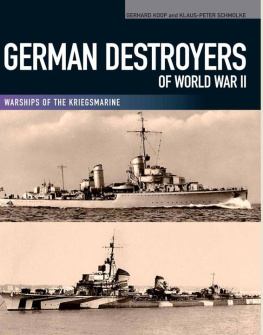EUMENES Publishing 2019, all rights reserved. No part of this publication may be reproduced, stored in a retrieval system or transmitted by any means, electrical, mechanical or otherwise without the written permission of the copyright holder.
Publishers Note
Although in most cases we have retained the Authors original spelling and grammar to authentically reproduce the work of the Author and the original intent of such material, some additional notes and clarifications have been added for the modern readers benefit.
We have also made every effort to include all maps and illustrations of the original edition the limitations of formatting do not allow of including larger maps, we will upload as many of these maps as possible.
DESTROYERS IN ACTION
By
Richard A. Shafter
Destroyers in Action was originally published in 1945 by Cornell Maritime Press, New York, as the first book in The US. Navy in Action Series.
Foreword
If there is one thing the war just ended has again demonstrated, it has been the ingenuity, courage and virility of our young American skippers. Destroyers and destroyer personnel have continued to uphold the outstanding record they established in the First World War. Not only are destroyers the work horses of the Navy, but they have inevitably become the spearheads of all surface fleet operations and attacks. It takes real seamen to operate these little fighting ships.
Mr. Shafter has brought out the many and varied ways in which destroyers are employed in wartime and has added many interesting items concerning their historical background. As an officer who has served much of his time at sea with destroyers, it is a delight to see these little vessels brought before the publictoo often the press is filled with the accounts of action by larger vessels and the outstanding work of the destroyers is overlooked. They are the Navys biggest school of seamanship and commandthe chance for young officers of ability and ambition to prove themselves.
The war just ended has again shown that sea power is indispensable to our nation. As long as we have navies, there will exist the necessity for destroyers to perform the multitudinous tasks so vividly portrayed in Destroyers in Action. No one can read this account of our destroyers in action without feeling a surge of pride and confidence in our American youth and without sensing that we had something the Japanese did not understandwe had a strength in our spirit which they did not comprehend; we had a latent power they could not estimate; we had an ability to carry the war to the enemy across thousands of miles of waterbeyond anything even our most ambitious Navy men had ever dreamed of.
The destroyer is undoubtedly the nursery for our future flag officersit develops strength of purpose, the power of rapid decision, of instant action and, if need be, of strenuous endurance through a period of danger. For these reasons the tales in Destroyers in Action are well worth reading.
H. F. LEARY,
Vice-Admiral, U.S. Navy,
Commander, Eastern Sea Frontier.
PART ONE GENESIS OF THE TINCANS
1. A Lovely Ship
Destroyers! Mention the word and the laymans mind will conjure up a picture of a little ship steaming death-defying, head-on into the fire from an enemy battlewagons heavy guns. In the heavy seaway the little ship is tossing like a cork, with the white water breaking high over her bows. Then suddenly she swerves hard to starboard. There are a couple of splashes on her portside and a moment later appear the bubbling wakes of the tin fish she has sent on their voyage of destruction. And a short while later there is a terrific crash. The enemys sides and decks are clothed in sheets of smoke and flame from the explosions that tear her inwards apart. And another naval battle is won.
It is an inspiring picture that has adorned many a calendar sent by solicitous ships chandlers and seed stores to their customers, to be remembered by for the rest of the year. The practice looks different. Whether its even more romantic than the calendar artist envisioned, or just a drab, humdrum existence, depends very largely on the point of view of the individual man who crews a tincan. One thing, however, can be said for it: its most versatile. If Kiplings crack about the liner has of late found an officially sanctioned variation to describe the glamour girl of the Navy, The Carrier, shes a Lady, then it can safely be varied once again: The destroyer, shes a workhorse.
Pulling binder, hay rig, threshing machine or the democrat for the family on its way to church, its all one to a farmers workhorse. A Navy workhorse may be on antisubmarine patrol today: dropping depth charges in their prescribed pattern all over the spot where the co-operating Navy flier believes he has seen the underwater raider; tomorrow, she may be riding herd on a convoy of merchantmen: running breathlessly and tongue-lolling around her flock, shooing stragglers into line, and then tackling, in the manner of good and faithful sheepdogs anywhere, all enemies regardless of size and number, whether aircraft, surface squadron, or wolf pack. Or they might install a pair of steel ovaries on her decks and give her a load of ugly horned eggs to drop in waters the enemys fleet is certain to traverse. Then again, they might give her a pair of paravanes to tow and send her out to sweep the channels leading to a new invasion beach clear of the mines which the enemy himself has sown there, and then the next day convert her into a fast transport and send her in with a deckload of Marine Raiders who are to establish the first beachhead foothold. And while weird landing craft are yet on their way with reinforcements, supplies, tanks and artillery, the destroyer that has landed them will stand by to give the Leathernecks who are digging themselves in on the narrow coral strip whatever fire support her 4-or 5-inch guns are capable of.
Then again, on duty with a task force, the destroyer is in the van and on the flanks of the capital ships, scouting, protecting, running interference and when the actual engagement begins, throwing a smoke screen around the carrier or battlewagon to spoil the enemys gunnery. When disaster comes, when carrier, battleship or cruiser has received the deadly wound that causes the decks to buckle and burst with the explosion of magazines and fuel tanks, its the destroyer that rushes in close, though the heat may blister what patches of paint are still left on her sea-bitten plates, and takes off the men still left alive after the unsuccessful battle to save their doomed ship. As the hull of the big capital ship slowly drifts down with the tide, a roaring inferno, yet still floating, it is the destroyers job to come in and send the once proud craft to the bottom with a torpedo, to save her from the last ignominy of having her dead body defiled by the enemys hands.
Rescue missions generally are hardly more than mere routine assignments among the manifold jobs that are a destroyers lot. Many a flier, shot down by ack-ack, or forced down in a gale, later got back in the fight simply because some indefatigable DD would not give up the search. A quart of whiskey for her skipper and ten gallons of ice cream for her wardroom became the traditional price that any carrier gladly paid to a DD for each of its fliers delivered back aboard or safely landed in port.












